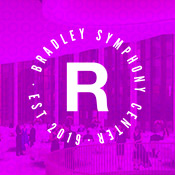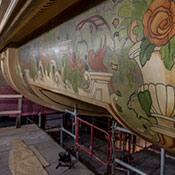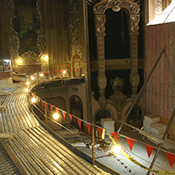
The Pavilion at the Bradley Symphony Center
David Lewellen
PUBLISHED
Tagged Under: Bradley Symphony Center, Grand Theater
While restoration work has continued on the Milwaukee Symphony’s historic concert hall, an equally important, and brand-new, section of the Bradley Symphony Center is taking shape.
The south addition, called the Pavilion, at the corner of Wisconsin Avenue and Second Street is the modern amenities counterpart to the experience of hearing a concert in a restored 1930s movie palace. Audiences of 80 years ago did not expect bars, skylights, reception rooms, or ample restrooms, but audiences in 2020 will get them in abundance.
“Whatever we did needed to be very clean and timeless and flexible,” said Chris Ludwig, an associate principal at Milwaukee’s Kahler Slater architectural firm. The glassy south building will offer a welcoming presence to the public on Wisconsin Avenue and be able to host a wide variety of events.
But the National Park Service had to approve the new building, since the historic preservation of the Warner Grand Theater was the centerpiece of the project. And a new addition to a historic building cannot clash with the original, but also cannot duplicate it. “Having something very glassy and transparent was a challenge, but it was something the symphony wanted,” said Ludwig, the lead designer on the project.
“A lot of public buildings in Milwaukee are fortresses,” said George Meyer, CEO of Kahler Slater. “They’re opaque and solid and foreboding. The symphony wanted something welcoming.”
“The historic building is beautiful,” Ludwig said. “Its masonry and stone and terracotta were significant for its era, and we don’t typically build modern structures in the same way. But the symphony asked for a south addition that would connect to the original building in a transparent, harmonious way, with a grand staircase and a skylight that showed the Richard Haas mural from the early 1980s on the office tower.
“Chris did a great job” of persuading the park service that a glass building could work, Meyer said. “They came around to it. It was a balance. But they definitely directed us to include more masonry in the Second Street face,” next to the historic wall.
The entire project is “a trifecta” of desirable results, Meyer said. It restores a historic building to use; it gives the symphony a chance to control its own destiny; and it can help the surrounding neighborhood. “We know art projects are typically a fantastic catalyst for the neighborhood,” he said. “Look at the Third Ward. Nothing was happening there until Skylight Opera moved in. We think same thing can happen in Westown.”
Within the entire space, both old and new, the symphony needs a harmonious look to its storytelling, signage, and branding. “Our storytelling weaves throughout entire project,” said Tony LaPorte, Kahler Slater’s team leader for environmental branding.
LaPorte decided on one typeface for all signage that works in both architectural styles. “We had to thread a needle to go in both buildings,” he said. In visual terms, “we need ‘volume control’, to make sure everything wasn’t shouting. We established a hierarchy of what was important.” The ornate historic theater is a very stimulating space, Ludwig said, but the new atrium and event space is much more restrained, and “Tony and the design team did a great job to stay in that vocabulary.”
In the new building, the architects emphasized vertical lines, to blend with the taller historic structure. The glass has been detailed with the names of composers in permanent ink; from a distance it looks like texturing, but up close the names are legible. That feature will also help the building change character from daylight to evening. “They wanted the building to have performative nature to it,” Ludwig said.
Working within the constraints of the historic preservation requirements “didn’t limit us in any way,” Meyer said. “They have to sit side by side. They have to coexist.”
“After being through the process, I really do appreciate (the park service’s) perspective in historic structures and what’s valuable,” Ludwig said. “As long as you understand what the parameters are, there’s always a creative solution.”
“It’s really important to the community and the MSO, and it’s developed into a passion project for all of us,” Meyer said. “We like designing buildings for the public. Something people come to see, to enjoy, for art – we love doing that.”



